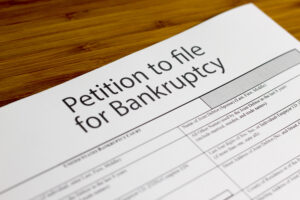Contents

Reviewing the bankruptcy petition and documents that your Michigan bankruptcy attorney prepares for filing with the US Bankruptcy Court is among your most important tasks within your own Chapter 7 or Chapter 13 process.
Part 4 of our series of Articles on how to read and review the bankruptcy petition prepared for you by your Michigan bankruptcy attorney will discuss in detail the all-important Chapter 7 and Chapter 13 bankruptcy Means Tests, as well as the balance of the petition documents you will be required to review.
In Parts 1, 2, and 3 of this Article, we described the points you should focus upon when reviewing the main substance of your draft documents: the Voluntary Petition for Bankruptcy itself, Certificate of Credit Counseling, Summary of Assets and Liabilities, the Petition Schedules, and the Statement of Financial Affairs.
What follows the Statement of Financial Affairs in the stack of papers your lawyer will hand you to review is less descriptive of you and your life and contains a little more “legalese.”
However, these forms are no less important to review for accuracy than the prior petition components described in this series of blog posts.
Statement of Intention for Individuals Filing Under Chapter 7
The first thing to note about the “Statement of Intention” is that, as you might guessed from its full title, it need only be completed and filed if you are filing for Chapter 7 bankruptcy.
If you are filing for Chapter 13 bankruptcy, this document will not be included in your petition filing. Instead, your Chapter 13 Plan covers the same ground.
-
Securing or Retaining Property Securing Debts?
For those filing Chapter 7, the purpose of this document is to publicly and clearly announce your intent to retain or surrender property serving as collateral for a secured debt.
If retaining the property, it requires also that you declare—by checking the appropriate box—whether you intend to enter into a Reaffirmation Agreement with the lender to whom you owed the secured debt.
A discussion of the question of whether you should or shouldn’t sign a Reaffirmation Agreement is outside the scope of this Article. For information on this separate but related topic, search our website blog for more information or discuss with your bankruptcy attorney.
If you are surrendering the property in the bankruptcy, that box should be checked.
If you want to retain your property and redeem it—discuss with your bankruptcy attorney. If you don’t know what that is, search our website for more information or, again, ask your bankruptcy attorney.
In short, however, redemption of property is an underused option in Chapter 7 that will allow you, for example, to buy your undervalued car out of the Bankruptcy Estate for what it is worth in fair-market value, discharging any excess amount owed to the secured lender for the car loan.
The Statement of Intention also requires that you check a “Yes” or “No” box as to whether you have claimed the property as exempt on Schedule C or not.
Typically, your home and vehicles should at least be listed here if you still owe money on mortgage or car loan debts. You may have other secured debts with associated collateral properties as well.
Here, you will want to review the creditors’ names and the description of the property securing the debt (e.g., “2016 Chevrolet Trax”) at a basic level.
If this information is not correct, likely an error was entered into Schedule A/B, so flip back to the related entry there for a deeper review. That will be the cause of the problem as most commonly used bankruptcy software programs simply populate the Statement of Intention from the prior Schedules.
If you know that you have collateral property securing a debt and don’t see it here at all, this means that the data describing the secured debt on Schedule D was improperly entered. In most cases, a box answering “Yes” to the question as to whether a Schedule D debt should be included on the Statement of Intention in your lawyer’s software program was not checked. Ask your lawyer to doublecheck this, as needed.
-
List Your Unexpired Property Leases
The second purpose of the Statement of Intention is to list any unexpired property leases that you may have along with your intention to “assume” or “reject” that lease.
Assuming a lease means that you are choosing to remain obligated under the terms of the lease.
Rejecting a lease means that you are discharging the related obligations of the lease in the Chapter 7 bankruptcy. (No, you don’t get to keep the leased property: you’ll need to return it to the lessor.)
A property lease is a lease for, well, property. If you lease your car, a car is property, so it ought to be listed here with all required details. If you lease a boat, a riding mower, or anything else that constitutes “property,” it should be disclosed here with your intention to assume or reject.
What about apartment leases? Or storage unit leases?
They are not “property,” but some bankruptcy attorneys will opt to list them anyway in order to clarify for a landlord or other lessor, during and after the bankruptcy, what happened, exactly. The lease assumption and rejection concept is not well known to many landlords, in particular.
If you are renting your home, are current with your rental payments, and want to keep renting your home, it sometimes avoids unnecessary confusion with your landlord to just list the rental lease with the “assume” box checked, although not mandatory.
This may have legal consequence, however, as recent case law in the Eastern District of Michigan (including Detroit) has afforded legal weight to declarations of assumption that do not exist otherwise.
Generally, checking one box or another here is not binding. The Statement may be amended by your lawyer at any time while your case remains open.
Statement of Attorney for Debtors Pursuant to F.R. Bankr. P. 2016(b)
This document is exclusive to the Eastern District of Michigan. If you are filing your Chapter 7 or Chapter 13 bankruptcy outside of the Detroit, Flint, or Bay City bankruptcy courts (which include Ann Arbor and Monroe), this form will not be included in your bankruptcy petition.
Your jurisdiction may have something similar in use, however.
This form simply requires that your bankruptcy attorney disclose how much you are being charged for your bankruptcy service. It requires disclosure by your attorney of how much of that you have paid in advance of filing and how much you will still owe after filing, if any.
Double-check this form to ensure that it jibes with the retainer agreement that you signed. If you paid a flat fee in full, in advance of filing, it should feature an amount charged followed by an amount paid, followed again by “$0.00” owed.
A Chapter 13 or other hourly-based billing engagement will include a line disclosing your attorney’s hourly billing rate.
If it looks good, sign at the bottom and move on.
Statement About Your Social Security Numbers
This “Statement” is the one place in the bankruptcy petition in which your full, unredacted Social Security Number is visible. It is not viewable electronically by the public through the Federal Court’s PACER system.
Only you see it, your bankruptcy attorney (and staff) see it, and the US Trustee and others in the background at the Bankruptcy Court will see it.
Nevertheless, it is crucial that you slow your review down and ensure that your Social Security Number as printed here is 100% accurate.
Failing to file with the correct SSN will result in the bankruptcy being reported to the credit bureaus for the wrong person. It is a difficult mistake to fully correct after the fact.
If it looks correct, sign at the bottom and move on.
But make darn sure that the number is correct before you do so.
Notice Required by 11 USC §342(b)
This “informational” sheet should already have been provided to you by your bankruptcy attorney by the time you’re sitting down to review your completed petition. Likely, it was provided to you at the time of your initial consultation appointment.
If not, read this now.
Otherwise known as the “Bankruptcy Information Sheet,” this “Notice” is canned information about the bankruptcy process that your lawyer is required by law to provide to you.
If you have questions about anything it says, ask your lawyer.
Otherwise, there is no need to memorize it … You will be asked at your 341 Meeting of Creditors hearing if you have read and understand the Bankruptcy Information Sheet. (Your Chapter 7 or Chapter 13 Trustee may refer to it by some other, slightly adjacent name.)
You simply want to be able to answer that question with an honest, “Yes.”
Verification of Creditor Matrix
The Creditor Matrix is essentially a list of mailing labels. All creditors, co-debtors, and other “parties of interest” included in your Schedules should be listed here. These are the individuals and companies who will receive notice of your bankruptcy filing automatically from the Bankruptcy Court.
Scan through the list. If it looks complete, sign on the “Verification” page signature-line, awkwardly placed in front of the Creditor Matrix rather than at the end of it.
How to Review Your Bankruptcy Petition: The Bottom Line
The bottom line with regard to these bankruptcy petition forms is that even the “boring” forms should be scrutinized carefully.
Your discharge and the success of your bankruptcy filing may be on the line.
Attorney Walter Metzen is a Board Certified Bankruptcy Expert who has successfully represented Metro Detroit Chapter 7 and Chapter 13 bankruptcy clients for over 30 years.
If you are considering filing for bankruptcy, contact us now to schedule your free initial consultation.




